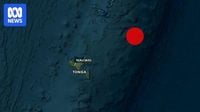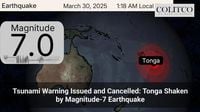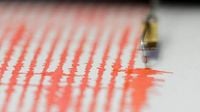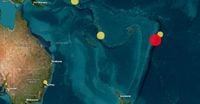A powerful earthquake struck near Tonga on the night of March 30, 2025, sending shockwaves across the region and prompting immediate concerns over a potential tsunami. The magnitude-7 earthquake hit approximately 100 kilometers northeast of Tonga at 11:18 PM local time, according to Geoscience Australia. This seismic event, occurring at a depth of 10 kilometers, was felt most intensely in the Ha’apai island group, where residents described the shaking as both violent and prolonged.
Ha’apai Governor Pita Taufatofua recounted the terrifying experience, stating, "Many things fell off tables and shelves, and the whole house shook. It was hard to stand up! It went for a very long time! Thank God we don’t have high rises here in Tonga." His sentiments were echoed by others in the region, including Salote Sisifa, CEO of Netball Tonga, who expressed her fears of a tsunami after feeling the quake. "Within two minutes, the sirens went off, and we knew we had to leave," she said, praising the public for their swift and organized response.
Authorities acted quickly, issuing a tsunami warning immediately after the earthquake, urging residents to move to higher ground or to the third floor of reinforced buildings. However, the US Tsunami Warning Centre later canceled the advisory, stating that the threat had passed. Despite this, fluctuations in water levels were recorded, with New Zealand’s tsunami buoys detecting a 70 cm rise in water height off Tonga’s coast.
This earthquake is part of a concerning trend of increased seismic activity in the region. In the past 24 hours alone, Tonga has experienced nine earthquakes, with a total of 178 quakes recorded in the past year. The largest of these recent seismic events was a magnitude-7 quake that struck 90 kilometers from Pangai, Ha’apai, earlier on the same day. Other significant quakes included a magnitude-6.2 tremor in the same area.
Recent seismic activity near Pangai, Ha’apai, Tonga included multiple earthquakes of varying magnitudes: a 5.3 magnitude quake five hours prior, several 4.8 magnitude quakes, and one 5.8 magnitude tremor. The Joint Australian Tsunami Warning Centre confirmed that despite the large quake, there was no tsunami threat to Australia.
Tonga, a nation of 171 islands, is situated in the Pacific Ring of Fire, which is known for its high levels of seismic and volcanic activity. The island nation has a population of just over 100,000, with most residents living on the main island of Tongatapu. Given its geographical location, Tonga is highly susceptible to earthquakes and tsunamis.
In light of the recent earthquake, local authorities have emphasized the importance of preparedness and safety during seismic events. They advise residents to follow safety protocols, including dropping to the ground, taking cover, and holding on until the shaking stops. For those outdoors, moving to open spaces away from buildings is crucial, while individuals in vehicles should pull over and remain inside until the shaking ceases.
The earthquake follows a tragic event just days earlier, where a 7.7-magnitude earthquake struck Myanmar, resulting in nearly 1,700 fatalities and widespread destruction. The juxtaposition of these seismic events highlights the ongoing vulnerabilities faced by island nations like Tonga, which were previously devastated by a tsunami in 2022 caused by a volcanic eruption, leading to three confirmed deaths.
As the dust settles from the latest quake, authorities continue to monitor the region for aftershocks. The community remains on high alert, prepared for any further seismic activity. With the increasing frequency of earthquakes, the need for robust disaster preparedness plans has never been more critical.
In the wake of these events, residents are reminded to stay informed and ready to respond quickly to any future tremors. Preparedness kits with food, water, and first-aid supplies are essential, as is knowledge of emergency protocols. The resilience of the Tongan people will be tested as they navigate the challenges posed by their unique geographical circumstances.










